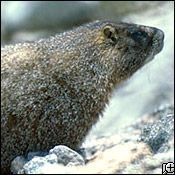Quck answer
The Alpine Marmot is a rodent species found in the European Alps. They live in colonies in burrows and hibernate for up to 8 months a year. They are social animals and communicate through a variety of vocalizations. Their diet consists mainly of vegetation, but they will also eat insects and small animals. The Alpine Marmot is considered a keystone species in their ecosystem as they help to maintain the alpine meadows by grazing and aerating the soil. However, they are also threatened by human activity such as tourism and hunting. Conservation efforts are underway to protect their populations.
Wild Animals

Alpine Marmot
PhotoDisc Green/Getty Images
Alpine marmots have unique sounds that they use to communicate. A prolonged whistle indicates danger from an aerial predator, like an eagle, while a series of whistles warns of the approach of a fox.
Like other marmots, they live in groups of ten to fifteen and are social animals.
They are herbivores and hibernate in underground chambers, sharing body heat to survive the winter. These chambers are cool and humid, but warmer than the ground surface.
Alpine marmot fat was once believed to have medicinal properties and was used by some mountain communities as a source of food and a delicacy.
However, the spread of agriculture has led to a decline in their population.
Animal Facts
Name: Alpine Marmot (Marmota marmota)
Family: Sciuridae (Squirrels)
Range: European Alps
Habitat: Open montane areas at 4,700 to 9,000 feet (1,433 to 2,743 m)
Diet: Grass, flowers, bulbs, seeds, insects, and birds’ eggs; occasionally each others’ young
Head and Body Length: 20 to 24 inches (50 to 60 cm)
Tail Length: 5 to 6 inches (13 to 16 cm)
Weight: 5 to 13 pounds (2.5 to 6 kg)
Life Cycle: Gestation 35 to 42 days, two to six young born
Description: Thick, gray to yellow-brown fur; large, round head; white nose; thick whiskers; short, round ears; short, powerful legs; large, blunt toenails; short, hairy tail with black tuft
Conservation Status: Not listed by the IUCN
FAQ
1. What is an Alpine Marmot?
An Alpine Marmot is a type of rodent that lives in the mountainous regions of Europe. They are known for their distinctive whistle-like call, which they use to communicate with each other. These animals are social creatures and live in large groups, called colonies, which can consist of up to 20 individuals.
2. What do Alpine Marmots eat?
Alpine Marmots are herbivores and primarily eat grasses, herbs, and other vegetation. During the summer months, when food is plentiful, they will also eat fruits and berries. In preparation for the long winter hibernation, they will spend much of their time during the autumn months gathering and storing food.
3. How do Alpine Marmots hibernate?
Alpine Marmots are well-known for their long winter hibernation period, which can last for up to seven months. During this time, they will reduce their heart rate, body temperature, and metabolic rate in order to conserve energy. They will also live off the fat reserves they have built up during the summer months.
4. What is the habitat of Alpine Marmots?
Alpine Marmots are found in the mountainous regions of Europe, including the Alps, the Carpathians, and the Pyrenees. They prefer to live in areas with rocky terrain, where they can dig their burrows into the ground. These burrows can be quite extensive, with multiple entrances, chambers, and tunnels.
5. Are Alpine Marmots endangered?
Alpine Marmots are not currently considered to be endangered, although their populations have declined in some areas due to habitat destruction and hunting. In some regions, they are protected by law, and efforts are being made to increase their numbers through conservation initiatives.
6. What is the life span of an Alpine Marmot?
Alpine Marmots typically live for 10-12 years in the wild, although some individuals have been known to live for up to 15 years. Their life span is shorter in captivity, where they may only live for 6-8 years. The exact life span of an individual marmot will depend on a variety of factors, including their health, environment, and genetic makeup.





Leave a Reply